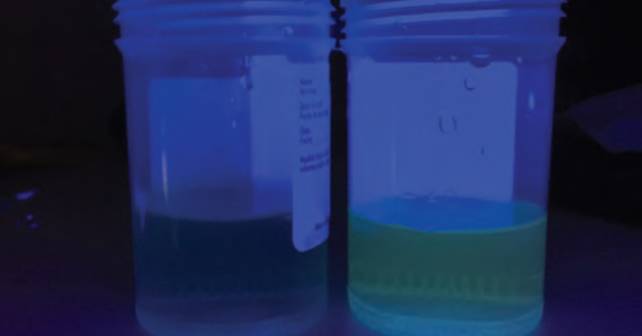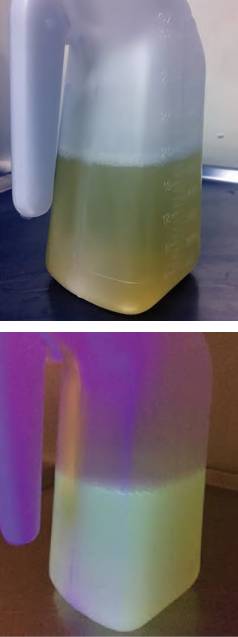

Explore This Issue
ACEP Now: Vol 42 – No 10 – October 2023FIGURES 2A and 2B: Patient’s urine under
normal light (TOP) and under Wood’s lamp
(ABOVE), demonstrating bright fluorescence
in urinal.
Research into urine fluorescence to help EG diagnosis has been both supportive and dismissive. Winter, et al., in 1990 showed nearly 100 percent detection after volunteer ingestion of fluoresceine at zero to two hours and 60 percent at four hours in volunteers.6 Other studies have shown poor detection and sensitivity of fluorescent presence in urine, false positives in children, and complication by fluorescence of the containers (some glass and plastic test tubes can glow), all of which may limit clinical use.9–11
In our case, despite having a markedly elevated EG level (130 mg/dL), the patient’s ED examination was normal; while his laboratory results were notable for elevated osmol gap (with no prior for comparison), he had normal renal function, no anion gap, urine that had no visual abnormality and no crystals. What he did have was brightly fluorescent urine—on its own and when compared with the bedside physician’s urine held in various identical containers (a urine cup, a urinal) and exposed to a Wood’s lamp. This information was considered in real time as supporting the presumptive diagnosis of EG ingestion and need for treatment.
Conclusion
Diagnosis of EG poisoned patients may be confounded by historical uncertainty, delayed return of definitive toxic alcohol levels, unreliable osmol gaps, and delayed development of other abnormalities. Although experimentally doubted, the detection of strongly positive fluorescent urine in the setting of a suspected recent ingestion of a fluorescein-containing EG product may bring additional support to initiation of therapy (before development of urinary crystals or an anion gap metabolic acidosis). The addition of a concurrent comparison with a control (even if your own) may also be useful. It may also be useful in resource-poor environments where laboratory testing is limited.
 Dr. Hack is chief of the division of medical toxicology and vice chair for research at East Carolina University in Greenville, North Carolina.
Dr. Hack is chief of the division of medical toxicology and vice chair for research at East Carolina University in Greenville, North Carolina.
References
- Gummin DD, Mowry JB, Beuhler MC, et al. 2021 annual report of the National Poison Data System (NPDS) from America’s poison centers: 39th annual report. Clin Toxicol (Phila). 60(12):1381-1643.
- Gessner PK, Parke DV, Williams RT. Studies in detoxication. 86. The metabolism of 14C-labelled ethylene glycol. Biochem J. 1961;79:482-489.
- Hoffman RS, Smilkstein MJ, Howland MA, et al. Osmol gaps revisited: normal values and limitations. J Toxicol Clin Toxicol. 1993;31(1):81-93.
- Takayesu JK, Bazari H, Linshaw MD. Case 7-2006: A 47-Year-Old Man with Altered Mental Status and Acute Renal Failure. N Engl J Med. 2006;354:1065-72.
- Boyer EW, Mejia M, Woolf A, et al. Severe ethylene glycol ingestion treated without hemodialysis. Pediatrics. 2001;107(1):172-3.
- Winter ML, et al. Urine fluorescence using a Woods lamp to detect the antifreeze additive sodium fluorescein: A qualitative adjunctive test in suspected ethylene glycol ingestions. Ann Emerg Med. 1990;19:663-667.
- O’Neil MJ. Merck Index. 13th ed. Whitehouse Station (NJ):Merck & Co;2001:736.
- Sharma S, Sharma, A. Robert Williams Wood: pioneer of invisible light. Photodermatol Photoimmunol Photomed. 2016;32:60-65.
- Wallace KL, Suchard JR, Curry SC, et al. Diagnostic use of physicians’ detection of urine fluorescence in a simulated ingestion of sodium fluorescein–containing antifreeze. Ann Emerg Med. 2001;38:49-54.
- Parsa T, Cunningham SJ, Wall SP, et al. The usefulness of urine fluorescence for suspected antifreeze ingestion in children. Am J Emerg Med. 2005;23:787–792.
- Casavant MJ, Shah MN, Battels R. Does fluorescent urine indicate antifreeze ingestion by children? Pediatrics. 2001;107(1):113-114.
Pages: 1 2 3 4 | Single Page




No Responses to “Toxicology Answer: An Illustrated Case of Ethylene Glycol, Direct and Indirect”